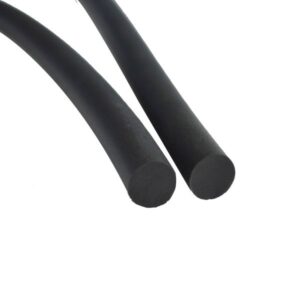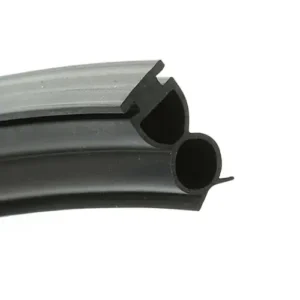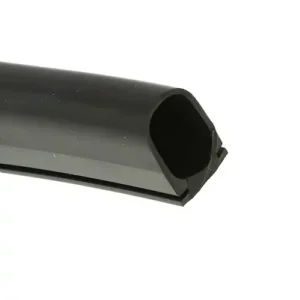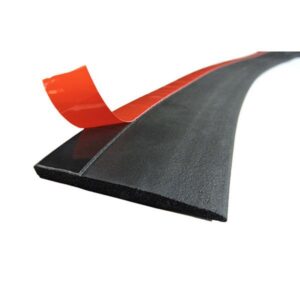Seal strips are essential in many industries, primarily for sealing and vibration-dampening applications. Among the commonly used rubber strips—EPDM, neoprene, and SBR—neoprene strips stand out due to several advantages. In this article, we explore the benefits of neoprene rubber and why it could be the ideal choice for your next project.
What Are Neoprene Strips?
Neoprene is a synthetic rubber made through the polymerization of chloroprene. Often referred to as neoprene tape, neoprene strips are used in a variety of forms, including seals, extrusion profiles, and gaskets. Regardless of the form, the material’s inherent properties provide significant benefits.
Neoprene rubber is known for its durability and resistance to oils, chemicals, water, and weathering. It comes in several types:
- Solid neoprene strips offer high hardness and excellent tensile strength, ideal for high-wear applications.
- Neoprene foam strips provide cushioning and vibration-dampening properties.
- Adhesive-backed neoprene strips are easy to install for quick sealing solutions.
12 Reasons to Choose Neoprene Strips

1. Toughness and Durability
Neoprene weather stripping is renowned for its strength, with a tensile strength ranging from 6.8MPa to 24MPa. Solid neoprene strips exhibit excellent tear and compression resistance, outperforming many natural and synthetic rubbers under demanding conditions.

2. Chemical Resistance
Neoprene strips offer outstanding resistance to petroleum-based oils, solvents, and many mild chemicals. This makes them ideal for industrial environments. However, caution is needed when exposed to harsh chemicals like acetone or excessive heat.

3. Waterproof Performance
Thanks to their closed-cell structure, neoprene strips are highly resistant to water absorption. They are widely used in marine, automotive, and outdoor applications to prevent moisture ingress and maintain a dry environment.
4. UV Resistance
Unlike many other rubbers, neoprene naturally resists UV degradation. It retains its elasticity, color, and integrity even after prolonged exposure to sunlight, making it ideal for outdoor installations.
5. Excellent Temperature Range (-29°C to 121°C)
Neoprene performs reliably across a wide temperature range, from -29°C to 121°C. While silicone rubber is better suited for extreme heat, neoprene is a robust and versatile option for most moderate temperature conditions.
6. Electrical Insulation and Fire Resistance
Neoprene is an effective electrical insulator and can handle high-voltage applications. It also offers moderate fire resistance, making it a safer option for electrical enclosures and industrial equipment.
7. Vibration Dampening
Neoprene foam strips excel at absorbing shocks and reducing vibrations, protecting sensitive machinery and improving operational efficiency. Solid neoprene, while less flexible, is better suited for structural applications.
8. Wide Durometer Range
Neoprene strips are available in a range of hardness levels (20 to 90 Shore A), catering to applications that require soft cushioning, medium firmness, or hard-wearing durability.

9. Customizable and Available in Various Colors
Neoprene can be easily customized into different shapes—profiles, sheets, tubes, or bumpers—and even comes with adhesive backings for easier installation. It is also available in multiple colors to meet aesthetic or functional needs.
10. Easy to Handle and Install
Lightweight and flexible, neoprene strips are easy to cut, shape, and install without specialized tools. Adhesive-backed options simplify the process even further, making neoprene perfect for both DIY projects and professional applications.
11. Long-Lasting Performance
Thanks to its resistance to weathering, chemicals, and mechanical wear, neoprene strips provide a durable sealing solution, reducing maintenance and replacement costs over time.
12. Cost-Effective Solution
Neoprene strips are competitively priced. For example, a standard neoprene tape (1″ x 1/8″ x 10′) costs around $12—more affordable than comparable EPDM ($17) or nitrile ($16) options. Combined with its long service life, neoprene offers an excellent return on investment.
Conclusion
Neoprene strips offer an unbeatable combination of durability, flexibility, chemical resistance, and waterproofing. Whether you need a robust weatherstrip for outdoor use or vibration dampening for machinery, neoprene provides a reliable, cost-effective solution.
Contact us today to learn more about how neoprene strips can meet your specific application needs.
